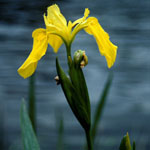Yellow Flag-Iris

Iris pseudacorus
Yellow Flag-Iris (Iris pseudacorus) is an eye-catching perennial, found in wet areas at low- to mid-elevations, growing in ditches, irrigation canals, marshes, stream and lake shorelines and shallow ponds.
Plants have showy yellow flowers with 3 sepals that curve backward and 3 petals pointing upwards. Leaves fold and clasp the stem at the base in a fan-like fashion. They stand erect or bent at the top, with long sword-like leaves toward the outside of the plant. At maturity, plants can reach 1.5 metres in height.
Yellow Flag-Iris reproduces quickly through seed dispersal and horizontal root systems, creating thickets in the water like cattails. Up to several hundred flowering plants may be connected rhizomatously under the water, and fragments can form new plants when they break off and drift downstream.
Yellow Flag-Iris is widely sold in nurseries and on the Internet for wet areas and well-mulched soil. While seeds disperse in the wind and water, popularity of the plant in the market worsen efforts to contain new infestations. Dense stands of Yellow Flag-Iris exclude native wetland species, threatening plant and animal diversity.
Warning: Yellow Flag-Iris can sicken livestock if eaten, though it is generally avoided by grazing animals. Contact with the resins can cause skin irritation in humans.
Resources
Yellow Flag-Iris ISCM Fact Sheet
Alberta Plant Council Fact Sheet
This information courtesy of Invasive Plant Council of B.C.
Back to Aquatic Invasive Species List
Â
© Copyright 2004-2025 - CMS Made Simple
This site is powered by CMS Made Simple version 1.4.1


